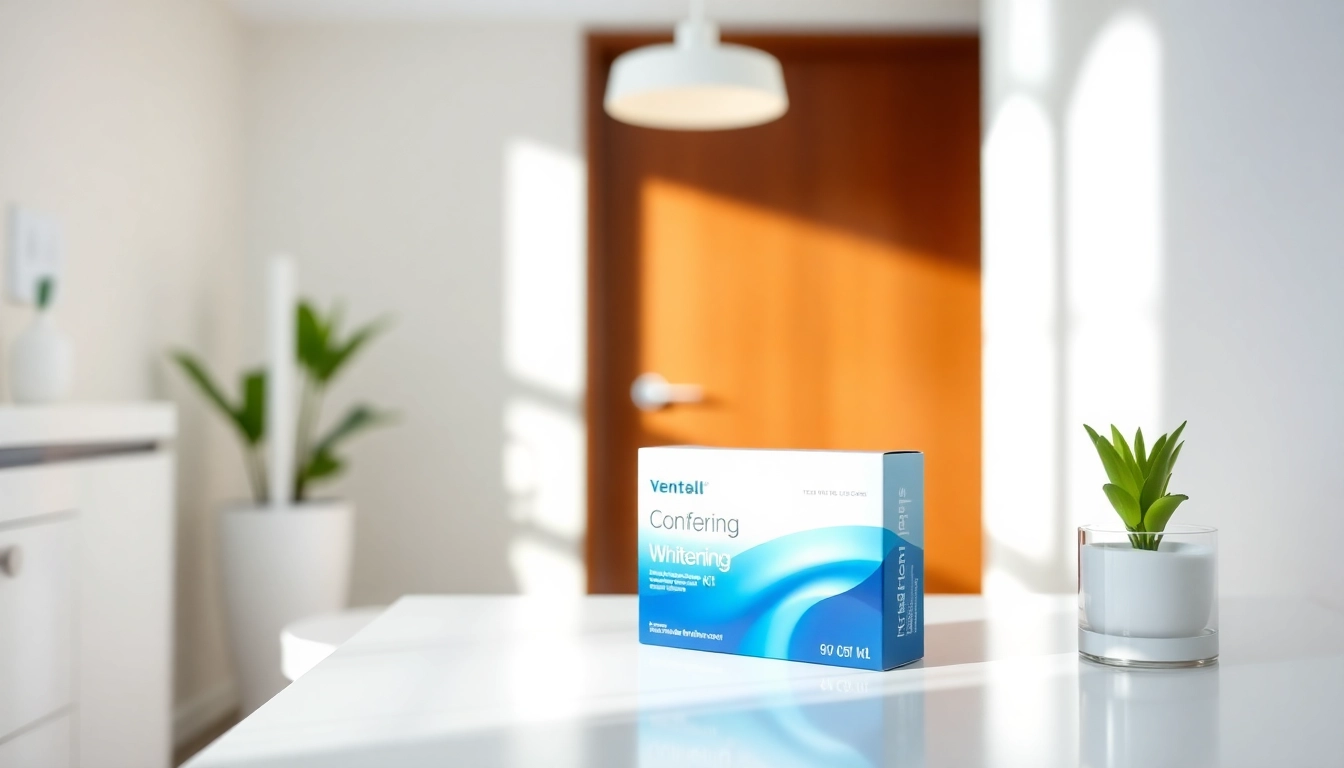Understanding Teeth Whitening Kits
What Are Teeth Whitening Kits?
Teeth whitening kits are specialized dental products designed to improve the brightness of your smile by reducing discoloration and stains on your teeth. They usually contain active ingredients, such as hydrogen peroxide or carbamide peroxide, which serve as bleaching agents. Teeth whitening kits are available for use at home or through professional dental services, catering to different preferences and budgetary constraints. These kits come in various forms, including strips, gels, pens, and tray-based solutions, each with unique features and application methods.
How Do Teeth Whitening Kits Work?
Teeth whitening kits function by breaking down stained molecules on the enamel surface through oxidation. The active ingredients penetrate the enamel and dentin layers, effectively lightening the color of the teeth. The application duration, concentration of the active ingredient, and individual dental health play vital roles in the results achieved. At-home kits generally offer milder solutions compared to professional options, requiring longer usage to achieve desired effects, while in-office teeth whitening treatments can yield instant results.
Benefits of Using Teeth Whitening Kits
There are numerous advantages to using teeth whitening kits:
- Convenience: At-home kits allow for flexible use at your convenience, eliminating the need for multiple dental appointments.
- Cost-effective: Professional whitening treatments can be expensive; over-the-counter kits provide a more affordable alternative.
- Variety: With numerous formulations available, users can choose options that best suit their needs, preferences, and budgets.
- Customizable Results: Users can adjust the frequency and duration of use based on their desired level of whiteness.
Types of Teeth Whitening Kits
At-Home Teeth Whitening Kits
At-home teeth whitening kits generally include products such as whitening strips, gels, and trays that can be easily used without professional supervision. They offer a more gradual whitening process, which can be ideal for those seeking subtle improvements. Products like Crest Whitestrips or AuraGlow provide easy-to-use applications, typically requiring daily use for a few weeks to see satisfactory results. Users appreciate the flexibility of at-home kits, as they can fit treatments into their existing routines seamlessly.
Professional Teeth Whitening Kits
Professional teeth whitening typically occurs within a dental office using higher concentrations of bleaching agents, which yield faster and more dramatic results. Techniques such as in-office laser treatments can achieve noticeable changes in just one session. Dentists may also provide take-home kits that are customized to the patient, often resulting in an effective combination of professional and home care. Although more expensive, professional options can be particularly beneficial for individuals with severe discoloration or those seeking swift improvements.
Natural vs. Chemical Whitening Kits
The debate between natural and chemical teeth whitening products has gained traction in recent years. While chemical whitening products utilize hydrogen peroxide or carbamide peroxide, natural alternatives often incorporate baking soda, activated charcoal, or coconut oil. Natural kits aim to provide gentler methods for those concerned about the effects of chemicals on teeth and gums. Although the effectiveness of natural products may vary, many users find them appealing for their potentially lower risk of sensitivity or irritation.
Choosing the Right Teeth Whitening Kit for You
Factors to Consider When Selecting a Kit
Choosing the appropriate teeth whitening kit involves several considerations:
- Dental Health: Consider existing dental conditions such as cavities, gum disease, or sensitivity, as these may influence your choice of whitening product.
- Desired Results: Determine how white you want your teeth to be and the timeframe in which you hope to achieve these results. Faster treatments typically require professional help.
- Application Method: Different products come with various application methods, so consider which format aligns best with your routine (strips, trays, etc.).
- Budget: Assess how much you are willing to invest, as prices of teeth whitening kits can vary significantly.
Top Brands for Teeth Whitening Kits
Some reliable brands in the teeth whitening market include:
- Crest: Known for their Whitestrips, which are effective and user-friendly.
- Zoom: Renowned for professional in-office whitening treatments and at-home kits.
- AuraGlow: Offers comprehensive kits that include LED lights for enhanced results.
- Colgate: Provides a range of products, including their Optic White line, which has been well-reviewed.
Reading Reviews and Features
When selecting a teeth whitening kit, it’s beneficial to read customer reviews and consider the features of each product. Factors like effectiveness, ease of use, taste, and potential side effects are commonly discussed in reviews. Websites and forums focused on dental health offer valuable insight into how well different kits perform among users. Engaging with content on sites like teeth whitening kit reviews can provide contextual understanding, helping you make an informed decision.
Proper Usage of Teeth Whitening Kits
Step-by-Step Instructions for Application
Proper application is crucial to achieve optimal results with teeth whitening kits:
- Read Instructions: Always begin by thoroughly reading the instructions provided with your kit to ensure effective and safe use.
- Brush and Floss: Maintain good oral hygiene by brushing and flossing before application to maximize whitening efficacy.
- Apply the Product: Follow the specific guidelines for your chosen kit, whether it be strips, gel, or trays. Ensure an even application and avoid excess contact with gums.
- Timing: Adhere to the recommended duration for treatment—both overuse and underuse can impact results.
- Rinse Thoroughly: After treatment, be sure to rinse your mouth to remove any remaining product.
Common Mistakes to Avoid
A few common mistakes can hinder the effectiveness of teeth whitening kits:
- Not Following Instructions: Skipping steps or altering recommended usage can lead to subpar results or potential sensitivity.
- Overuse: Extended or excessive use of whitening agents can harm tooth enamel and lead to discomfort.
- Ignoring Dental Conditions: Individuals with dental issues should avoid whitening until they address those problems with their dentist.
- Neglecting Oral Hygiene: Maintaining regular dental hygiene practices can influence the success of whitening treatments.
How to Maximize Results
To ensure you achieve the desired whiteness, consider these tips:
- Consistent Application: Follow a regular routine as outlined in the product instructions to achieve gradual improvement.
- Diet Choices: Limit consumption of foods and drinks that may stain teeth (e.g., coffee, red wine).
- Follow Up with Maintenance: Consider using whitening toothpaste or dental care products designed to extend results.
- Consult Your Dentist: For personalized recommendations and adjustments based on your specific dental needs.
Aftercare for Optimal Results
Maintaining Your Whitened Smile
Once you’ve achieved your desired level of whiteness, maintaining it is essential:
- Regular Cleaning: Keep up with regular dental visits for cleanings to prevent plaque buildup, which can dull the whiteness.
- Daily Hygiene: Brushing twice daily with whitening toothpaste can assist in maintaining brightness.
- Mouthwash Use: Incorporate a mouthwash that prevents staining and promotes oral health.
Foods to Avoid After Whitening
Several foods and beverages can contribute to the re-staining of teeth shortly after whitening treatments:
- Coffee and Tea: Their tannins can trigger stains on the freshly whitened enamel.
- Red Wine: Similar to coffee, red wine contains pigments that can re-stain teeth.
- Sauces: Tomato sauce and soy sauce contain rich pigments that may contribute to staining.
- Certain Berries: Blueberries and blackberries, while nutritious, can stain due to their dark color.
Monitoring Sensitivity and Long-Term Care
Many people experience increased tooth sensitivity after using whitening kits. Here’s how to manage sensitivity:
- Use Sensitive Formulations: Some whitening kits come specifically designed for sensitive teeth, which can reduce discomfort.
- Take Breaks: If sensitivity occurs, take a break between sessions or consult a dentist for alternative options.
- Use Desensitizing Toothpaste: A desensitizing toothpaste can help alleviate discomfort associated with sensitive teeth.



